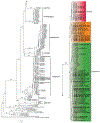Extreme High-Elevation Mammal Surveys Reveal Unexpectedly High Upper Range Limits of Andean Mice
- PMID: 38781524
- PMCID: PMC12232203
- DOI: 10.1086/729513
Extreme High-Elevation Mammal Surveys Reveal Unexpectedly High Upper Range Limits of Andean Mice
Abstract
AbstractIn the world's highest mountain ranges, uncertainty about the upper elevational range limits of alpine animals represents a critical knowledge gap regarding the environmental limits of life and presents a problem for detecting range shifts in response to climate change. Here we report results of mountaineering mammal surveys in the Central Andes, which led to the discovery of multiple species of mice living at extreme elevations that far surpass previously assumed range limits for mammals. We livetrapped small mammals from ecologically diverse sites spanning >6,700 m of vertical relief, from the desert coast of northern Chile to the summits of the highest volcanoes in the Andes. We used molecular sequence data and whole-genome sequence data to confirm the identities of species that represent new elevational records and to test hypotheses regarding species limits. These discoveries contribute to a new appreciation of the environmental limits of vertebrate life.
Keywords: Andes; Phyllotis; Puna de Atacama; distribution limits; high altitude; species limits.
Figures



Update of
-
Extreme high-elevation mammal surveys reveal unexpectedly high upper range limits of Andean mice.bioRxiv [Preprint]. 2023 Aug 23:2023.08.22.554215. doi: 10.1101/2023.08.22.554215. bioRxiv. 2023. Update in: Am Nat. 2024 Jun;203(6):726-735. doi: 10.1086/729513. PMID: 37662254 Free PMC article. Updated. Preprint.
References
Literature Cited
-
- Cadenillas R, and D’Elía G 2021. The number of species of degus (genus Octodon) is currently underestimated: an appraisal of species limits and their phylogenetic relationships (Rodentia: Hystricomorpha: Octodontidae). Molecular Phylogenetics and Evolution 159:107111. - PubMed
-
- Hortal J, de Bello F, Diniz-Filho JAF, Lewinsohn TM, Lobo JM, and Ladle RJ 2015. Seven shortfalls that beset largescale knowledge of biodiversity. Annual Review of Ecology, Evolution, and Systematics 46:523–549.
-
- Jayat JP, Teta P, Ojeda AA, Steppan SJ, Osland JM, Ortiz PE, Novillo A, Lanzone C, and Ojeda RA 2021. The Phyllotis xanthopygus complex (Rodentia, Cricetidae) in Central Andes, systematics and description of a new species. Zoologica Scripta 50:689–706.
References Cited Only in the Online Enhancements
MeSH terms
Grants and funding
LinkOut - more resources
Full Text Sources
Miscellaneous

